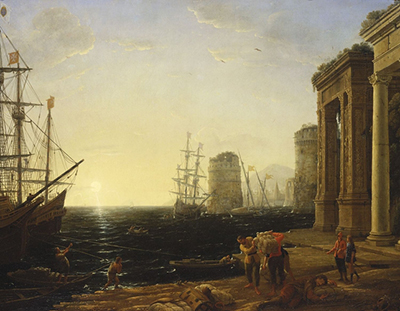Harbour Scene at Sunset is a relatively similar composition to another Claude Lorrain artwork, namely Cleopatra Disembarking at Tarsus. This piece was completed in 1643 and resides today within the Royal Collection, Windsor, UK.
The painting features yet another harbour scene from this artist's career, from which there are many others to enjoy too. Claude loved to capture a bright sun reflecting across the waves and seascapes gave him the opportunity to do this, whilst also incorporating other content elsewhere in each piece. We find tall structures to the right hand side with classical styles that he regularly used. There are also a number of tall ships and figures in the foreground that also were a trademark of his career. He may not have been particularly well skilled in portraiture or figurative art, but he would still add humans and animals into most of his paintings. At the very least they could bring a sense of perspective to these awe-inspiring scenes. Notice how the foreground items are much darker, where as the ship in the distance is lightened in order to get the impression of distance into our minds.
Claude was a French artist who achieved most of his success whilst living in Italy. He sold paintings for high prices once his reputation had peaked but in centuries after his death his popularity would rise even further and wider. British collectors would start to become interested in his work as well, and their acquisitions would help bring about a popularity in the country for landscape painting. That is why today so many of his paintings still reside within the UK, some of which, like Harbour Scene at Sunset, can be found within the highly respected Royal Collection. Its artifacts are distributed between the different venues and properties owned by the Royal Family, many of which remain open to the public for most of the year. Others remained within Italy and France, with a small number also now present in the US, including a large number of his drawings plus prints for his etchings.
At just under one metre in width, this piece is actually relatively small by the normal standards of this artist. He produced an earlier drawing which has been well documented which would have served as a study piece, in order to prepare this composition. He would actually make some changes from the earlier piece such as moving the round tower across to the right hand side. He also amended some of the figures in the foreground, though this would have been much easier to do at a late stage, without impacting the fundamental structure of the piece. It is believed that some research into the painting in the 1960s brought about new discoveries on issues such as its date of creation. During some routine cleaning and preservation of the piece, certain things came to light which forced a slight re-evaluation of this painting. This re-thinking is very common within art history, particularly as new methods of research appear every few generations.




